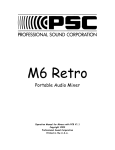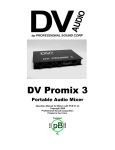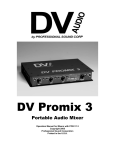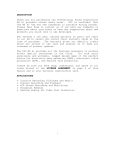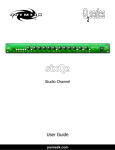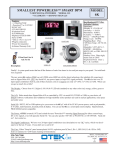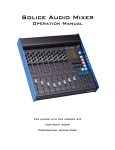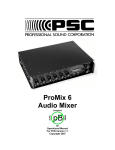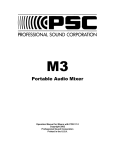Download Professional Sound Corporation M 8 Specifications
Transcript
M 8 MIXER MANUAL Operation Manual V1.0 Copyright 1998 Professional Sound Corporation Printed in the U.S.A. Introduction Professional Sound Corporation is a leading manufacture and distributor of professional audio products for the film and video industries. Since 1986, Professional Sound Corporation has provided excellence in product engineering, assembly and service. Many Professional Sound Corporation product innovations originated from our customer's ideas based upon their own field equipment requirements. With the help of our many valued customers, we are continually developing new and more efficient products to add to our line. Our products cover virtually every aspect of the production audio for film and video. These products include: audio mixers, boom poles, phone interfaces, RF antennas, microphones, microphone power supplies, distribution amplifiers, equipment carts, cables adapters and more. At Professional Sound Corporation, we believe that you, our customers, are our most important asset. We continually strive to offer you superior product support both before and after the sale. Our staff is always available to assist you in any way possible. We want you to feel free to call upon us anytime for product information, dealer location or simply to offer you comments or suggestions regarding the Professional Sound Corporation product line. Additionally, our world wide network of dealers have been carefully chosen to provide you with the best possible product support. In addition to our own line of products, Professional Sound Corporation is a Master Distributor for the Electro-Voice line of Broadcast Microphones. These exceptionally rugged microphones are used extensively throughout the ENG, television and radio industries and have set the standards by which others are judged. Finally, Professional Sound Corporation is the exclusive U.S. distributor for the van den Bergh line of carbon fiber boom poles. Due to a combination of superior strength, rigidity and light weight construction, VDB have become number the one boom pole sold in America for nearly a decade. You may contact us at: Professional Sound Corporation 28085 Smyth Drive Valencia CA 91355 PHONE (661)295-9395 FAX (661)295-8398 E-mail [email protected] Homepage www.professionalsound.com Copyright 1998 Professional Sound Corporation, all rights reserved, no portion of this manual may be reproduced or used for commercial purposes without the express written permission of PSC. Entire contents, descriptions, specifications and photos are the exclusive property of PSC. PSC, the PSC logo, and M8 are registered trademarks Professional Sound Corporation. TABLE OF CONTENTS 1. DESIGN OVERVIEW 2. INPUT SECTION: 2.01 2.02 2.03 2.04 2.05 2.06 2.07 2.08 2.09 2.10 2.11 2.12 3. BALANCED OUTPUTS AUXILARY OUTPUTS MIXER HEADPHONE OUTPUT BOOM HEADPHONE OUTPUTS DIRECTOR HEADPHONE OUTPUT REFERENCE OSCILLATOR SLATE MICROPHONE PRIVATE LINE BOOM COMMUNICATIONS REMOTE ROLLS TAPE RETURNS LITTLITE TM PAGE 6 PAGE 6 PAGE 6 PAGE 7 PAGE 8 PAGE 8 PAGE 8 PAGE 9 PAGE 9 PAGE 10 PAGE 10 PAGE 10 POWERING: 4.01 4.02 4.03 4.04 4.05 5. PAGE 2 PAGE 2 PAGE 3 PAGE 3 PAGE 4 PAGE 4 PAGE 4 PAGE 4 PAGE 5 PAGE 5 PAGE 5 PAGE 5 OUTPUT SECTION: 3.01 3.02 3.03 3.04 3.05 3.06 3.07 3.08 3.09 3.10 3.11 3.12 4. TRANSFORMER INPUTS MICROPHONE POWER INPUT LEVELS PHASE REVERSAL PREAMP GAIN HI PASS FILTERS LIMITERS EQUALIZATION CHANNEL ASSIGNMENTS CHANNEL FADER AUXILARY ASSIGNMENTS PRE FADER LISTEN PAGE 1 INTERNAL BATTERIES EXTERNAL POWERING RECHARGEABLE BATTERIES GROUNDING OVERLOAD PROTECTION PAGE 11 PAGE 11 PAGE 11 PAGE 12 PAGE 12 METERING: 5.01 METER STANDARDS PAGE 12 5.01 6. CHASSIS CIRCUITRY COMPONETRY PAGE 14 PAGE 15 PAGE 15 MIXER MODIFICATIONS PAGE 15 CONNECTORS 9.01 10. PAGE 13 PAGE 13 PAGE 14 PAGE 14 MODIFICATIONS 8.01 9. POWER AMPLIFIERS INTERNAL SPEAKERS EXTERNAL SPEAKERS DRIVING EXTERNAL AMPLIFIERS CONSTRUCTION: 7.01 7.02 7.03 8. PAGE 13 MONITOR SPEAKERS: 6.01 6.02 6.03 6.04 7. LCD METERS CONNECTOR PIN OUTS SPECIFICATIONS PAGE 16 PAGE 17 INPUT SECTION: 2.01 TRANSFORMER INPUTS The M8 mixer uses a transformer coupled input preamp design topology. Transformer coupled inputs were chosen for their "forgiving" abilities in field production. First and most importantly, they provide a high level of galvanic isolation which simply stated, means your equipment and you may live should the M8 inputs come into contact with incompatible sources (high voltages!). Secondly, because they provide this isolation, transformer coupled inputs are inherently less susceptible to ground loop induced hum. Lastly, transformers, if properly applied provide pleasing sound characteristics. The transformers used in the M8 Mixer feature a 1:4 step up ratio and six sided Mu Metal shielding. Additionally, they are printed circuit board mounted types and thus, do not suffer from unshielded, noise sensitive leads common to the transformers used in other mixers. All transformers are tested prior to being inserted and soldered to the printed circuit boards. It should also be noted that the transformers are operated well below their design limits in order to provide improved sound quality and performance. 2.02 MICROPHONE POWER: The M8 Mixer provides all standard types of condenser microphone powering. The front panel mounted three way selectable switch allows the user to select "12T", "Dynamic" or "48PH" All microphone powering provided by the M8 Mixer is well regulated, filtered and meets or exceeds DIN specifications. "12T" or Tonador powering is an older standard favored in Hollywood before the days of efficient DC to DC converters. Though none of the newest microphone designs operate on "12T", many older microphones as well as existing designs such as the Sheops CMC4 tm and the Sennheiser MKH416T tm continue to be manufactured and represent a substantial part of the microphone market. In the past, "12T" existed under two standards. The first standard, popular in the USA, was called none other than "standard phase". Standard Phase refers to the 12Vdc operating voltage being applied between pins 2 and 3 with pin 2 being positive with respect to pin 3. To the best of our knowledge, this standard was adopted by Sennheiser for all new microphones shipped in the USA. The second and less popular standard of "12T' microphone powering is referred to as "red dot". Microphones wired to operate on "red dot" are wired so that pin 3 is positive with respect to pin 2. Additionally, it was a practice in Hollywood to paint the Sennheiser case retaining screw "red" as to identify the microphone as being wired to red dot standards. In 1992, the Audio Engineering Society formally announced that "Standard Phase" would from that day forward be accepted and used. The A.E.S. standards also refer to a positive pressure transient applied to a microphone traducer causing a resulting positive voltage output signal on pin 2. Enough trivia, the M8 mixer delivers "12T" to the A.E.S standards of pin 2 positive. Owners of "red dot" wired microphones can easily power them from the M8 Mixer using a phase inverting barrel (PSC part # FPSC0010C) or a phase reversing cable (PSC part # FPSC1017). Page 2 Dynamic of "DYN" powering actually refers to no power being supplied. It is used with all dynamic microphones such as those from Electro-Voice, Sennheiser, Shure, and others. The mixer should also be set to "DYN" when ever a line level input is connected such as a wireless receiver, lavilier microphones with barrel style supplies, disc players or another mixer. 48 Phantom or "48PH" has become the powering standard for all new condenser microphone designs. "48PH" microphone power supplies 48Vdc to both pin 2 and 3 with respect to ground (pin 1) The term "phantom" refers to the fact that you can apply phantom powering to standard dynamic microphones with any effect or harm. This is because there is a positive 48volts being applied to both pins and thus there is no difference of potential (voltage) across the dynamic microphone element. Although 48PH can safely be applied to most pieces of equipment without causing damage, there are exceptions to this rule and thus it is a good practice to only provide 48PH powering to condenser microphones designed to operate on it. Improperly applied 48PH may cause excessive current to flow from the 48PH source and reduce the battery life of the M8 Mixer. 2.03 INPUT LEVELS: The M8 Mixer is designed to accept both line and microphone level signals. The M8s' nominal input signal range is from -50dB to +10dB. A front panel mounted switch determines the mixers input range. When switched to "Line" a balanced attenuator circuit of approximately 40dB is inserted ahead of the first preamp circuit. When switched to "MIC" this balanced attenuator circuit is effectively removed from the circuit. Supplying line level signals to an input set to "MIC" level will result in severe signal distortion. Transversely, supplying a microphone level signal to an input set to "LINE" level will result in a barely audible and noisy signal. 2.04 PHASE REVERSAL: The M8 Mixer allows for the reversal of audio phase of incoming signals. The front panel switches are marked "0" and "180" referring to degrees of phase rotation or reversal. "0" being in phase with the mixers outputs and "180" being out of phase with the mixers outputs. Phase reversal is used when two microphones of different types are used together and in close proximity to each other. If one is out of phase with the other, signal loss will occur. Additionally, phase reversal is sometimes used to reduce unwanted background noise. Please note that this switch does not affect "12T" powering phase as mentioned in paragraph 2.02. Page 3 2.05 PREAMP GAIN: The preamplifier circuits of the M8 are split in two distinct gain stages separated by a "gain" control. The heart of both gain stages is an Analog Devices Corp. OP-275tm dual operational amplifier. This amplifier was chosen for its "good sound" characteristics. It utilizes the Butler tm front end design and features low noise, low distortion specs and a generous gain-bandwidth product. This results in good transient response. The first gain stage is followed by a level control with a 20dB range. The output of this control is fed to the second gain stage which adds an additional 20dB of gain. This two stage design provides very high headroom and ease of use. This results in the ability to handle dialog from a normal speaking voice to a "scream" without resetting gains and without signal clipping (severe distortion). 2.06 HI PASS FILTERS: Each preamp is equipped with an active high pass filter. The circuitry chosen is that of a Stallen Key Filter network and it provides 12dB per octave roll off of low frequencies. It has six shelving frequencies. The first or "flat" position allows flat frequency response down to 20Hz. It's 3dB down point is approximately 10Hz. The next five steps raise this 3dB down point up to a maximum of approximately 280Hz. The high pass filters are primarily used to eliminate wind rumble and microphone handling noise. *Note* only use as much low frequency roll off as necessary. The post production sound mixing personnel will appreciate it! 2.07 LIMITERS: Each preamp is equipped with its own individual limiter. These limiters utilize a six position rotary switch and a level pot for control. The six way switch provides an "off" position and five different signal compression ratios. These ratios vary from a mild 1.2 to 1 signal compression to a hard 4 to 1 signal compression. The threshold or attack point of the limiter is fully adjustable via a rotary pot. Limiter action is indicated by the front panel green "Lim" LED. The M8 mixers preamp offers excellent "headroom" so normally, the limiter is not needed. The limiters are useful when wide dynamic ranges of audio are expected. These include shouts, gunshots, etc. It is also worth noting that some types of recording devices offer limited headroom and are easily overloaded. In this case, the limiters can serve to alieviate this overload condition. 2.08 EQUALIZATION: The M8 Mixer is equipped with 3 way equalization. The mid frequency equalization has a parametric (center frequency) adjustment. This allows the operator to fine tune the equalization for the job at hand. The high frequency equalization has a center frequency of 10Khz and allows a cut or boost of 10dB. The mid frequencies center frequency is adjustable from 2Khz to 5Khz. It offers a cut and boost of 10dB. The low frequency equalization has a center frequency of 100Hz and offers a cut and boost of 10dB. Page 4 2.09 CHANNEL ASSIGNMENTS: The M8 Mixer is equipped with two channel assignment switches per input channel. These switches allow the operator to assign the output of any given preamp to either of the two pan pots. The operator has a choice of assigning the preamp signal to pan pot 1 & 2, pan pot 3 & 4, or none at all. In this case, the two auxiliary feeds and the individual channel line output remain active. The channel assignment switches are connected via pan pots to mix buses one through four. When switched to the "off" position, the signal input to the pan pots is switched to ground. Switching unused input channels to the "off" position will eliminate any noise being added accidentally should the operator leave an input fader open. Additionally, switching off all unused inputs will lower system noise very slightly. 2.10 CHANNEL FADER: The M8 Mixer uses P & G conductive plastic slide faders. These faders allow the operator over 70dB of range. Front panel markings allow the operator to note level "locations". P & G Faders were chosen for their smooth and quiet operation. These faders are primarily designed for high end studio mixers but are adaptable for field use. The operator should note that these faders are not environmentally sealed and can be damaged by use in overly dusty and dirty and/or wet environments. If they are properly cared for and kept reasonably clean, they will provide years of service life. However, if abused they can become stiff and/or noisy. Please note that while the M8 Mixer comes with a one year warranty, fader contamination is not covered under the warranty. It should also be noted that excessive downward pressure on the fader knobs can result in damaged fader slide assemblies. P & G makes smooth, precision and expensive faders, please treat them as such. 2.11 AUXILIARY ASSIGNMENTS: The M8 Mixer contains two auxiliary busses. They can be used for many purposes including additional feeds for crew members, transmitter feeds, etc. Both auxiliary feeds feature user level controls and are pre or post fader selectable. Pre fader allows the auxiliary send signal to be sent regardless of fader position. Alternatively, post fader assignment allows the auxiliary send signal level to "follow" the fader. The first auxiliary send is pre/post fader selectable via a front panel switch. Auxiliary two is also pre/post selectable, but via an internal circuit board mounted jumper. The bottom panel of the mixer must be removed to access these jumpers. They are factory set to post fader. 2.12 PREFADE LISTEN: The M8 Mixer is equipped with prefade listen. Each preamp has a momentary PFL button located directly above the channel fader. When the PFL button is pressed, audio from that individual input channel is routed directly to the "mixer" headphones. The normal headphone source is momentarily interrupted while the PFL audio is sent to the mixer phones. PFL is used to isolate the audio from one individual channel. This is helpful when checking setups, verifying proper wireless operation, etc. Page 5 OUTPUT SECTION: 3.01 BALANCED OUTPUTS: The four main outputs of the M8 Mixer are electrically balanced and designed to drive 600 Ohm loads. Nominal output level is +4dBm. The outputs are capable of driving more than 1000 feet of high quality audio cable, and provide a common mode balance of greater than 45dB. The outputs emulate the finest transformers but with improved phase response. The outputs can be unbalanced by tying either pin 3 (standard procedure) to ground or by tying pin 2 to ground. Output level (gain) does not measurably change between balanced and unbalanced. RF filtering is standard on all M8 balanced outputs. 3.02 AUXILIARY OUTPUTS: The M8 Mixer is equipped with two auxiliary outputs. These outputs are unbalanced and are available on rear panel mounted "TT" connectors. Nominal output level is 10dBm. These outputs are capable of driving 600 ohm loads. Overall output levels are adjusted via front panel rotary pots. The auxiliary outputs feature RF filtering to help in interfacing to RF transmitters of various types. 3.03 HEADPHONE OUTPUTS-MIXER: The M8 "Mixer" headphone feeds are stereo and capable of driving any headphone with an impedance of 25 to 600 Ohms. The front panel mounted rotary switch offers the following program selections: 1. 2. 3. 4. 5. 6. MAIN OUTPUT ONE TO BOTH EARS-MONO MAIN OUTPUT TWO TO BOTH EARS-MONO MAIN OUTPUTS ONE AND TWO-STEREO MAIN OUTPUTS ONE AND TWO SUMMED-MONO MAIN OUTPUTS THREE AND FOUR-STEREO AUXILARY OUTPUT ONE-MONO In addition, sources one through four may be switched to monitor "tape" returns as outlined in paragraph 3.11. Volume for the "Mixer" headphone amplifiers is controlled via a six position rotary switch located just below the mixer selection switch. This stepped switch was chosen over a conventional rotary volume control to allow precise "memory" locations of level settings. In practice, most professional sound mixers ride (adjust) their recording levels via perceived headphone levels and little attention is paid to meter readings. This being the case it is important that your headphone levels be set the same each time the mixer is operated. It is recommended that you choose one of the five active gain positions on this switch that provides you with a comfortable listening level and leave the switch set to this position under all normal recording conditions. Page 6 *SAFETY NOTE* Always adjust the headphone volume to the lowest setting before listening to unknown material. It is also highly recommended that you listen at the lowest practical volume as to further protect your hearing and future livelihood. Excessive sound pressure levels can cause permanent hearing damage. The M8 mixer contains headphone power limiting devices designed to aid in protecting your hearing by limiting power output to reasonable levels, HOWEVER, the operator has final control over listening levels relevant to ambient sound levels, headphone brands, types and efficiencies, and must decide what is appropriate. Professional Sound Corporation makes no guarantees as to the effectiveness of the power limiting devices within the M8 Mixer being fit for any particular application, circumstance or listening level. Because of this, Professional Sound Corporation, its employees, officers and shareholders accept no responsibility regarding actual hearing protection. Use Your Head, Turn It Down, Save Your Ears ! 3.04 HEADPHONE OUTPUTS-BOOMS The M8 Mixer is equipped with two independent mono headphone feeds designed to feed boom operators. They are designated as Boom 1 and Boom 2. They also feature independent six way source selection switches located on the front panel. Each of the two boom outputs can be selected as follows: 1. 2. 3. 4. 5. 6. MAIN OUTPUT ONE MAIN OUTPUT TWO MAIN OUTPUTS ONE AND TWO SUMMED-MONO MAIN OUTPUT THREE MAIN OUTPUT FOUR MAIN OUTPUTS THREE AND FOUR SUMMED-MONO Standard rotary volume controls are located below each of the two boom selection switches. The Boom headphone feeds will drive any headphone with an impedance of 25 to 600 Ohms. They also contain the same power limiting devices as described in the safety note paragraph above. Audio is normally provided to the boom operator according to the source selection made, there are exceptions however. When the "Private Line" button is pressed, both boom feeds will automatically be switched from providing standard program audio to monitoring the slate microphone. Also, if the Boom Com is being used, program audio is also momentarily overridden. All of these functions are switched electronically and are click free. Page 7 3.05 HEADPHONE OUTPUTS-DIRECTOR The M8 Mixer is also equipped with an additional headphone feed labeled as "Director". This headphone feed is also monoral and has a six way source selection switch. The director headphone feed can be selected as follows: 1. 2. 3. 4. 5. 6. MAIN OUTPUT ONE MAIN OUTPUT TWO MAIN OUTPUT THREE MAIN OUTPUT FOUR AUXILIARY ONE AUXILIARY TWO The director headphone feed remains consistent to its selection. It is not affected by the Boom Com or private line features. All of the headphone feeds contained within the M8 Mixer have RF filtering and can be used to feed most RF transmitters for wireless headphone feeds. 3.06 REFERENCE OSCILLATOR: The M8 Mixer is equipped with a reference oscillator that can be used for both line up tones or tail tones. The front panel switch has both a momentary position and a fixed "on" position. The oscillator is factory adjusted to an "A-440" tone (440 Hz). While many audio manufacturers use 1KHz as a reference tone, we have chosen 440Hz because it is much more pleasant while wearing headphones than a 1KHz tone. We successfully pioneered the use of 440Hz as a standard on our M4 and M4A+ portable mixers. The oscillator is always routed to outputs 1 & 2 and can be assigned to outputs 3 & 4 and the auxiliary outputs via front panel mounted switches. 3.07 SLATE MICROPHONE: The M8 Mixer comes with a built in slate microphone. This slate mic is used to put voice slates (take numbers, etc.) on your recordings. Slate operation is accomplished by simply pressing the red "slate" button. This switch is momentarily and will only operate the slate microphone as long as the button is pressed. The "slate" audio is always assigned to outputs 1 & 2. Additionally, it can be assigned to outputs 3 & 4 and/or the auxiliary busses. These two front panel assignment switches also select the assignment of the tone oscillator. The M8 Mixer slate microphone features a 27Hz sub audible tone used to easily identify slates during editing. This feature can be turned off internally if desired. Page 8 3.08 PRIVATE LINE: The private line provides a discreet one way (simplex) communication from sound mixer to both boom operators. It can be used during recording without audio being sent to the recorder. When the "private line" button is pressed, the output of the slate microphone is routed directly to the two "boom" headphone amps. Private line is used by the sound mixer to discreetly notify the boom operator of changes, boom corrections, etc. 3.09 BOOM COMMUNICATIONS: The M8 Mixer provides full duplex communications between the sound mixer and two boom operators. Included in this system are "call" lights from the boom operators to the mixer. In practice, the boom operator can send a "call" signal to the sound mixer by pressing a "call" button on their hip worn duplex cable box. When the button is pressed, a call lamp on the front panel of the M8 will light. The mixer operator can at his or her will, press the Boom Com toggle switch towards the direction of the lit LED. When the boom com switch is pressed, the slate microphone is routed directly to that particular boom phone amplifier. At the same time, the mixer phones are interrupted and the signal from the boom operators talk back mic is fed to the mixer phones. Full duplex communication is established and does not interfere with the production audio being mixed. It should be noted that two complete duplex boom communication systems are built into the M8. PSC manufactures more duplex (boom) cables than any other company. We stock them in standard lengths of 50', 75', 100', 125', 150' and can produce them in various custom lengths upon request. To utilize the complete boom communication system capabilities, requires the use of special PSC "duplex communicator" cables. These cables contain a third shielded pair of cables that carry the talkback audio and "call" light signaling voltages. These signals are carried on a separate shielded mic cable to avoid any cross talk to the production audio tracks. The hip worn duplex communication cable box contains a 1/4" mono headphone connector and a 3 pin female chassis XLR like our standard duplex cables. In addition, they contain a small electret microphone element, a push button switch and a mono mini female jack. The push button activates the "call" light on the mixer panel. If the mixer operator chooses to speak to the boom operator, he then does so. If not, the boom operator is powerless to override the mixers headphone audio selection. The mono mini female jack is used when the boom operator wishes to use an external talk back microphone. This jack provides positive bias to external electret microphones. You can use any of the various positive bias lavilier microphones on the market such as the PSC Millimic. Also, dynamic microphones can be used if a DC blocking capacitor is installed. Page 9 3.10 REMOTE ROLLS: The M8 Mixer is equipped with dual remote rolls (recorder controls). The remote roll circuitry is quite simply a pair of switched relay (isolated) contacts that can be used to remotely control Nagra tm recorders, bell and light systems etc. The front panel switch and corresponding red and green LEDs are used to control two separate isolated relay outputs. These relays are rated to handle control voltages up to 24Vdc at 250Ma. When the front panel "red" LED is lit, the relays are off. When the front panel "green" LED is lit, the relays are on. As the relays are single pole, double throw types, they can be set up as normally open contacts or normally closed contacts. This selection is made via internal board mounted selection jumpers. These jumpers are factory set to "normally closed". This corresponds for use with Nagra tm recorders and some of the after market DAT interface devices. *SAFETY NOTE* These relays and corresponding circuitry are designed for "pilot duty" (low power) only! Do not connect to any external device exceeding 24Vdc. Excessive voltages can damage the M8 and/or pose significant safety hazards (shock hazards). 3.11 TAPE RETURNS: The M8 Mixer is equipped with four tape returns (tape monitors) allowing the mixer operator to monitor tape as well as the direct signal. Monitoring tape is also known as confidence monitoring as you are "confident" that your mix has been recorded. To monitor tape requires specific cables to allow the "tape delayed" audio signal to be inputted to the M8. These cables are connected to the rear panel "TT" connectors marked T1 through T4. Once the proper connections are made, monitoring tape is as simple as flipping the front panel mounted tape/direct switch. To make the M8 mixer tape return amplifiers compatible with many types of recorders and their various signal levels, the M8 contains level adjustment trim pots located on the front panel. These trim pots should be adjusted so that the direct signal level is matched by the tape signal level. 3.12 LITTLITEtm The M8 Mixer includes an industry standard LITTLITEtm. This flexible gooseneck style lamp easily attaches to the M8 Mixer via the chassis mount BNC connector. This connector is located on the front panel, left of the meters. The LITTLITEtm is powered by a separate voltage regulator in order to reduce overall system noise. The lamp is switched on via a rocker switch located below the BNC connector. The M8 power supply circuitry is rated to supply up to 5 watts. This allows the use of "high intensity" bulbs. (A high intensity LITTLITEtm is included with the M8 Mixer) please note that the high intensity LITTLITEtm draws approximately 5 watts, nearly the same as the entire M8 Mixer. Use of this light will dramatically shorten battery life! Page 10 POWERING: 4.01 INTERNAL BATTERIES: The M8 Mixer was designed from the ground up as a portable and thus battery powered mixer. The batteries are conveniently located inside the fader wrist rest. They can be easily replaced without moving the mixer or disrupting any cabling. To access the batteries, you must simply unscrew the two cover retaining screws and lift off the battery box cover. The M8 mixer operates on ten (10) alkaline "D" cells. In consideration of the power requirements of the M8 mixer, inexpensive carbon type batteries should not be used. Alkaline cells will provide approximately 12 hours of operation. Battery condition is indicated by the two LED's located next to the red power switch. Good batteries are indicated by the presence of a lit green LED. Low batteries are indicated by a lit red LED. *SAFETY NOTE* Always remove batteries when storing the mixer. Do not allow batteries to completely discharge while remaining in the mixer. Battery leakage may result in severe mixer damage (corrosion). This is not covered by warranty. We recommend you use only high quality, name brand alkaline batteries such as Duracell tm MN1300. 4.02 EXTERNAL POWERING: The M8 Mixer is able to operate from external voltages from 10 to 18 Vdc. Power consumption is approximately 10 watts. External power is applied to the M8 Mixer via a standard XLR 4 pin connector. Pin 1 is ground (-) and pin 4 is positive (+). Pins 2 and 3 are used only for rechargeable batteries. The M8 Mixer is supplied with a universal AC power supply. This small, compact AC adapter will operate world wide without adjustment. Input specifications allow its use from 100 to 240 Vac, 50-60Hz. The input AC cord is removable and uses a standard IEC connector. World wide operation simply requires an appropriate AC cord or adapter plug. 4.03 RECHARGEABLE BATTERIES: The M8 Mixer can be operated on rechargeable NiCad batteries in place of standard alkaline cells. It should be noted that typical NiCad "D" cells are rated at 4000mA/hours as opposed to alkaline cells typical rating of 14,000 mA/hours. In consideration of this, the operating time will be reduced to approximately 3.5 hours. NiCad batteries can be recharged from an appropriate external charger connected to the external power input XLR connector. Pin outs are as follows: Pin 1 ground (-), Pin 3 charge current input (+). NiCad batteries should be charged at a 400 mA/Hr rate for 12-16 hours. Page 11 4.04 GROUNDING: The M8 Mixer offers an excellent signal to noise ratio. In order to preserve this specification you should only use properly built and grounded cables. All balanced audio cables (XLR cables) should be properly case (connector shell) grounded. In the case of AC powered equipment, it is a common procedure to tie the cable shield to the male XLR end of the cables. In the case of battery powered equipment, it is our experience that XLR cables should have the shield tied to case ground at both ends of the cable. When the M8 Mixer is operated from its supplied AC power supply, the mixer chassis is connected to earth ground. Caution should be taken when operating from unknown AC feeds. We have repaired a great deal of equipment that has been damaged on motion picture sets because the AC supplied to the sound man was incorrectly wired. This includes reversed hot and neutral, reversed hot and ground, etc. This is very dangerous for both the equipment and operator. We recommend you purchase an inexpensive outlet checker to add to your equipment kit. These small outlet checkers look like a 3 prong plug with several lights on the back. A proper pattern of lit lights indicates proper and safe AC. 4.05 OVERLOAD PROTECTION: The M8 Mixer does not rely on conventional replaceable fuses. We have chosen instead to use a more reliable and self resetting device. After extensive evaluation and testing, we have settled on the Raychem Polyfuse tm. The Polyfuse tm behaves similar to a standard fuse in that it interrupts excessive current flow. Unlike a standard fuse that must be replaced after each use, the Polyfuse tm is self resetting upon power down. In the unlikely event that your M8 Mixer suffers an over current condition, it will shut down until it is powered down (turned off) for 20 to 30 seconds. After this time, the Polyfuse tm will automatically reset itself. In addition to the Polyfuse tm, the M8 Mixer contains steering diodes to offer further protection from reverse polarity conditions. If the M8 Mixer is inadvertently fed from an externally supply of reversed polarity, it will not be damaged, but instead it will simply not turn on. METERING: 5.01 METER STANDARDS: In the world of audio, there are two primary audio metering standards. The first and older standard is that of the V.U. meter. This standard was developed in 1961 and is still popular in the USA. The V.U. (volume unit) meter is average reading and was designed to approximate the equivalent loudness as perceived by the human ear. Since the V.U. meter is average reading, it is well suited for most types of analog recording. Page 12 The second meter standard is the PPM or peak program meter. Peak reading meters differ from V.U. meters in that they display the peak value of an audio signal rather than the average value. Peak reading meters made their debut years ago on Nagra tm recorders. Nagra tm formulated their own "peak" standards that do not conform to the "PPM" standard formulated years later by the BBC. True PPM meters respond to very fast transient peaks that would be ignored by a V.U. meter. This is especially important when recording to any digital format. Digital recorders produce very harsh distortion if overloaded. It should be noted that there are more than a dozen PPM standards worldwide and this furthers confusion surrounding the PPM standard. 5.02 LCD METERS: The M8 Mixer contains six LCD meters monitoring outputs one through four as well as the two auxilary outputs. These meters are peak reading and provide 40dB of visual indication. These meters will respond to very fast transients and will display the peak value. In practical use on dialog or music, you will find that these meters display the peak value as the highest segment shown. You can also interrupt the average value by looking for the highest solidly lit segments. We believe you will find this feature most useful. It should be noted that these LCD displays operate at approximately 40Hz and may offer a less than steady display on steady state very low frequencies such as 20 to 50 Hz test tones. MONITOR SPEAKERS: 6:01 POWER AMPLIFIERS: The M8 Mixer contains a pair of stereo power amplifiers. They are used to drive the M8's built in speakers. They can also be used to drive external speakers with an impedance rating of 4 to 8 Ohms. These amplifiers will provide a maximum of about 1.5 watts output each into the internal 4 Ohm speakers of the M8 Mixer. That will provide the same power output to external speakers as well. These power amplifiers follow the same source selection as the "mixer" headphones (see paragraph 3.03). They feature an independent stepped volume control located directly below the "mixer" phones volume control. These amplifiers can be used to provide playback for directors, between take monitoring, etc. 6.02 INTERNAL SPEAKERS: The M8's internal speakers are very small 40 mm (1.57") and offer limited bandwidth. This is a trade-off between performance and size and weight. The speakers performance is limited, and is not representative of the speaker amplifiers performance. Page 13 6.03 EXTERNAL SPEAKERS: As mentioned in paragraph 6.01 the M8 Mixers speaker amplifiers will drive any speaker from 4 to 8 Ohms. These can be small two or three way cabinets such as Bose Roommates tm or larger cabinet types such as those offered by Electro-Voice tm, Klipsh tm, or JBL tm. Full range speakers will provide suprisingly good results from the internal power amplifiers of the M8 Mixer. 6.04 DRIVING EXTERNAL AMPLIFIERS: The external speaker connections of the M8 Mixer can also be used to drive external high power speaker amplifiers such as those made by Electro-Voice tm, QSC tm, Hafter tm and others. Some precautions must be observed. The M8's internal speaker amplifiers operate in bridged configuration, because of this, you must not unbalance the speaker outputs of the M8. Additionally, the speaker outputs have 2.5 VDC present at all times. Since most power amplifiers have input coupling capacitors, this presents no problem. If you have any problem, it can be corrected by installing DC blocking capacitors in your cables. We recommend 47 Mf @ 10 Vdc or greater. CONSTRUCTION: 7.01 CHASSIS: The M8 Mixer is built around a heavy duty, welded aluminum chassis. This chassis was designed to stand up to years of field use. It is formed from 0.125" (3.2mm) 5052-H32 aircraft aluminum. All holes are precision punched on a computer controlled "Stripit" tm punching center. The entire back panel, speaker panel, meter panel, and top panel is formed from one piece of aluminum for greater rigidity and strength. After punching, this flat sheet is hand formed to its final shape. Structural side panels, and the battery tray are then T.I.G. welded in place using precision jigs. Finally, the entire chassis is measured for straightness and dimensional accuracy. T.I.G. (tungsten inert gas) welding provides superior strength and less metal warpage in the hands of a skilled welder. Additionally, the inert gas shielding of the welding process dramatically reduces impurities within the weld and thus lessens the chance of future weld failures (cracking). Once the chassis is finished it is hand sanded smooth, thoroughly cleaned, and bead blasted prior to painting. We then have an epoxy based powder coat finish electrostatically applied and baked on. This finish is very durable and scratch resistant. Finally, we use a sub-surface silk screening method on a hard face Lexan tm overlay. The silk-screening is applied to the bottom side of a clear Lexan tm layer so it is permanent and cannot wear off like conventional silk screening. This overlay covers a majority of the mixer and can easily be cleaned with a damp, soft cloth. The side panels of the M8 Mixer are decorative in nature. They are screwed onto the actual, welded structural sides of the housing. These side panels also feature three stainless steel threaded inserts (6-32 thread) that can be used for various purposes such as mounting recorder shelves or securing your M8 Mixer to a sound cart. Page 14 7.02 CIRCUITRY: The circuitry of the M8 Mixer was designed over a three year period. Battery powered mixers represent a serious challenge to the design engineer because they face a series of design trade-offs based on power restrictions. While many of our competitors claim their designs are made "without compromise" this simply is not true. Battery power represents a serious limitation by anyones standards. Component choice must follow very strict guidelines and power limitations. Operating a fully featured eight channel mixer on less than 10 watts is quite an achievement. We believe we have chosen components that provide the best possible audio quality at a reasonable power consumption rate. 7.03 COMPONETRY: All of the components used in the construction of the M8 Mixer are the finest available. We have chosen to use Penny & Gies tm faders, Clarostat tm conductive plastic rotary pots, NKK tm environmentally sealed switches, and Neutrik tm connectors. Additionally, we have chosen semi conductors from National Semi Conductor tm, Analog Devices tm, Texas Instruments tm, and others. Finally, our circuit boards are made of F-4 glass epoxy and manufactured to mil specs. All componentry is soldered using "no clean" solder. This solder uses drastically less flux resulting in cleaner boards. 8.01 MODIFICATIONS: The M8 Mixer represents a careful and conservative design. We have done our best to provide you with a very flexible, reliable and high quality mixer. Therefore, we recommend that you do not modify the design in any way. Many modifications can adversely affect operational specifications, power consumption and reliability. Additionally, non factory authorized modification will result in your warranty being void. Page 15 9.01 CONNECTOR PIN OUTS: The following information is provided for use of technicians and other qualified individuals desiring to build various cables for use with the M8 Mixer: Preamp Input XLR's Pin 1 = Pin 2 = Pin 3 = Ground Audio HI (12T Pwr +) Audio Low (12T Pwr -) Preamp Insert TT: TIP = Ring = Audio Output @ 0dBV Minimum External Device Input Impeadance of 10K Ohm Audio Return @0dBV Maximum External Device Output Impeadance of 100 Ohms Ground Sleeve = Preamp Line Out TT: TIP = Pre Fader Ring = Post Fader Sleeve = Ground Minimum External Device Input Impeadance of 10K Ohm Main Output XLR's: Pin 1 = Ground Pin 2 = Audio HI Pin 3 = Audio Low Rated Impeadance = 600 Ohms, Actual = 50 Ohms Auxiliary Outputs TT: TIP = Audio Output @ 0dBv Ring = N.C. Sleeve = Ground Minimum External Device Input Impeadance of 10K Ohm Tape Returns TT1-2: TIP = Tape One Ring = Tape Two Sleeve = Ground Comm Input TT3-4: TIP = Tape Three Ring = Tape Four Sleeve = Ground Input Impeadance = 10K Ohm, Level = -10dBv to +10dBv TT-1: TIP = Mic Input w/ positve bias Ring = Call Light Signing, (Tie to Ground to Activitie Light) Sleeve = Ground Speaker TT-2: Same As Above TT: Tip = Speaker (+) Ring = Speaker(-) Sleeve = No Connection Page 16 SPECIFICATIONS: Chassis Size: 14.75"W x 18.00"D x 3.00"H (37.4cm x 45.7cm x 7.6cm) Chassis Material: 0.125" 5052-H32 Aircraft Aluminum (3.2mm) Fully T.I.G. Welded Bottom Cover: 0.062" 5052-H32 Aircraft Aluminum (1.6mm) Paint: Electrostatically Applied Epoxy Powder Coat with U.V. Inhibitors Overlay: 0.005" Hardface Lexan tm with Sub-Surface Epoxy Ink Silk Screening Weight: 16 lbs (7.3Kg) Without Batteries Internal Power: 10 x "D" Alkaline Cells Battery Life: Approximately 12 Hours, less use of LittLite or Speakers External Power: 10 to 18 Vdc at 10W (less use of Littlite or Speakers) Inputs: Transformer Balanced 1 K Ohm Input Impeadance (Mic Level) 6 K Ohm Input Impeadance (Line Level) Outputs: Balanced, XLR 3 Pin 600 Ohm Rated, 50 Ohm Actual HP Filter: 12 dB/Octave 10 Hz to 270Hz, In 6 Steps Equalization: 3 Way with Parametric Mid Frequency Adjustment Low Frequency: +/-10dB @ 100 Hz Mid Frequency: +/-10dB @ 2Khz to 5 Khz High Frequnency: +/-10dB @ 10Khz Limiter: 100 uS Attack Time 100 mS Release Time 1.2:1 to 4:1 Compression Ratio in 5 steps Variable Attack Point Mic Power: 12T, 48PH, Dyn to DIN Specs Meters: LCD Bargraph, Peak Reading, 40dB range Page 17 Monitor Speakers: Stereo, 40mm, 1 watt per channel Faders: Penny and Giles tm 83mm Conductive Plastic Rotary Pots: Clarostat tm Conductive Plastic, Environmentally Sealed Switches: NKK, Environmentally Sealed Signal to Noise: -128.5dBU (150 Ohm, Equivalent Input Noise) -131dBU ( A Weighted) THD + Noise: 00.08% Typical





















